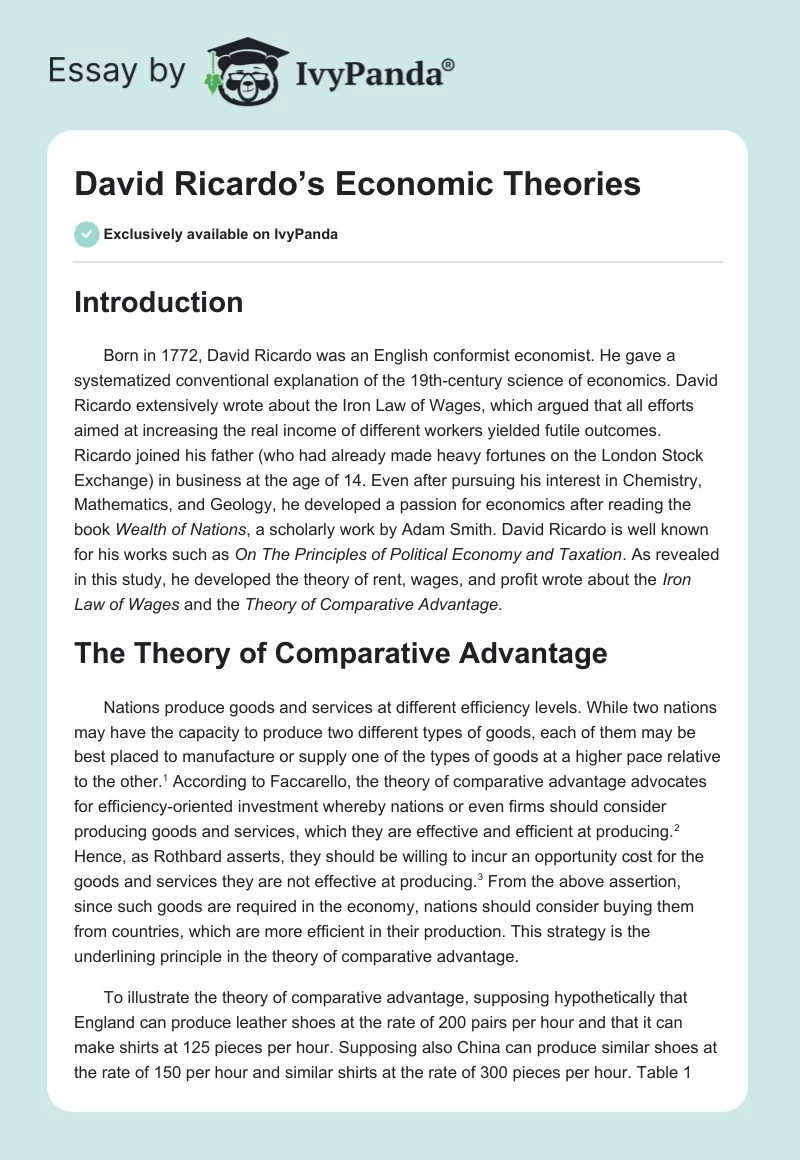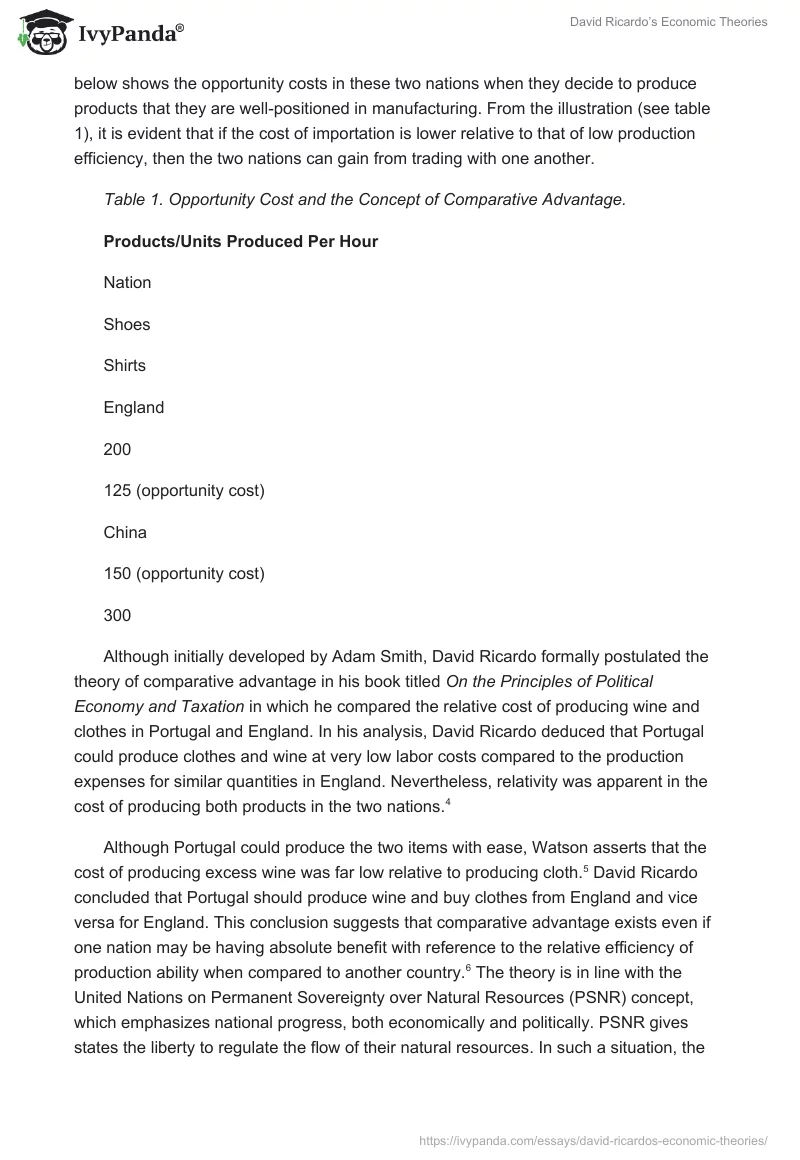Introduction
Born in 1772, David Ricardo was an English conformist economist. He gave a systematized conventional explanation of the 19th-century science of economics. David Ricardo extensively wrote about the Iron Law of Wages, which argued that all efforts aimed at increasing the real income of different workers yielded futile outcomes. Ricardo joined his father (who had already made heavy fortunes on the London Stock Exchange) in business at the age of 14.
Even after pursuing his interest in Chemistry, Mathematics, and Geology, he developed a passion for economics after reading the book Wealth of Nations, a scholarly work by Adam Smith. David Ricardo is well known for his works such as On The Principles of Political Economy and Taxation. As revealed in this study, he developed the theory of rent, wages, and profit wrote about the Iron Law of Wages and the Theory of Comparative Advantage.
The Theory of Comparative Advantage
Nations produce goods and services at different efficiency levels. While two nations may have the capacity to produce two different types of goods, each of them may be best placed to manufacture or supply one of the types of goods at a higher pace relative to the other.
According to Faccarello, the theory of comparative advantage advocates for efficiency-oriented investment whereby nations or even firms should consider producing goods and services, which they are effective and efficient at producing. Hence, as Rothbard asserts, they should be willing to incur an opportunity cost for the goods and services they are not effective at producing. From the above assertion, since such goods are required in the economy, nations should consider buying them from countries, which are more efficient in their production. This strategy is the underlining principle in the theory of comparative advantage.
To illustrate the theory of comparative advantage, supposing hypothetically that England can produce leather shoes at the rate of 200 pairs per hour and that it can make shirts at 125 pieces per hour. Supposing also China can produce similar shoes at the rate of 150 per hour and similar shirts at the rate of 300 pieces per hour. Table 1 below shows the opportunity costs in these two nations when they decide to produce products that they are well-positioned in manufacturing. From the illustration (see table 1), it is evident that if the cost of importation is lower relative to that of low production efficiency, then the two nations can gain from trading with one another.
Table 1. Opportunity Cost and the Concept of Comparative Advantage.
Although initially developed by Adam Smith, David Ricardo formally postulated the theory of comparative advantage in his book titled On the Principles of Political Economy and Taxation in which he compared the relative cost of producing wine and clothes in Portugal and England. In his analysis, David Ricardo deduced that Portugal could produce clothes and wine at very low labor costs compared to the production expenses for similar quantities in England. Nevertheless, relativity was apparent in the cost of producing both products in the two nations.
Although Portugal could produce the two items with ease, Watson asserts that the cost of producing excess wine was far low relative to producing cloth. David Ricardo concluded that Portugal should produce wine and buy clothes from England and vice versa for England. This conclusion suggests that comparative advantage exists even if one nation may be having absolute benefit with reference to the relative efficiency of production ability when compared to another country.
The theory is in line with the United Nations on Permanent Sovereignty over Natural Resources (PSNR) concept, which emphasizes national progress, both economically and politically. PSNR gives states the liberty to regulate the flow of their natural resources. In such a situation, the lecture notes by Seay also concur that comparative advantage is successful in reducing the cost of running an economy.
The Theory of Rent, Profits, and Wages
David Ricardo left the legacy of having developed the theory of profits, rent, and wages. According to Depoortère, Ricardo presented rent as “the difference between the produce obtained by the employment of two equal quantities of capital and labor.”
As Czyżewski and Matuszczak confirm, the theory argues that economic development leads to higher cultivation of poor virgin land, which only left landowners as the principal beneficiaries. He used the term rent to describe the personal benefits arising from the utilization of scarce resources. The term also captures the concept of positive externalities whereby such benefits may be enjoyed by third parties without financially hurting the targeted organization, person, or property owner.
In his theory of profits, he argued that augmented wages resulted in decreased real profits since revenue derived from manufactured goods and services has wages and profits as the main two components. To illustrate this concept, consider a shirt costing 50 USD. Here, the manufacturer has included a certain amount of wages plus a profit margin in arriving at the price. Therefore, if the cost of the shirt cannot exceed 50 USD due to economic factors such as demand and supply, high wages decrease the profit levels. He also noted that profits varied depending on the cost of necessities.
The Iron Law of Wages
The Iron Law of Wages is an economic theory suggesting that real earnings tend to fall within minimum wages appropriate for a worker to sustain his or her life in the long-term. As Baumol asserts, the theory has its roots anchored on classical economics, including David Ricardo’s theory of rent.
According to Depoortère, this school of thought emphasizes, “market price of labor would always, or almost always, tend toward the minimum required for the subsistence of the laborers, reducing as the working population increased and vice versa.” David Ricardo observed that this situation could only happen under some conditions. In explaining such circumstances, he drew a distinction between the market and the natural price of labor.
The natural price implies the cost of maintaining different workers or laborers not only physically but also in compliance with diverse customs within a nation. Market price entails the real wages paid to laborers. Ricardo observed that market price could forever exceed the level of the natural wage akin to diverse countervailing tendencies in different economies. To illustrate this theory, in a manufacturing firm, owners of the factors of production and capital must not only pay wages agreed upon in the employment contract (market price wages) but also incur other costs such as supporting employees or laborers’ training and development (natural wage).
Accuracy of David Ricardo’s Theories
Although other suppositions may be precise, Depoortère observes that the theory of rent and profits might be useful but not accurate since it relies only on land economic issues. One major demerit is that it presumes that land can only be applied in farming and that outputs increase disproportionately with capital and labor.
As Depoortère reveals, Ricardo claimed that an increase in population implies the need to cultivate more land to guarantee adequate food supplies. However, having a substantial land under cultivation attracts extra expenses, a situation that introduces questions concerning the accuracy of the postulated theory.
The relevance of David Ricardo’s Theories to the Present Economy
David Ricardo’s theories are relevant to the present economy. For example, according to Watson, the theory of comparative advantage is accurate in predicting circumstances under which international trade flourishes. By deploying the theory, nations that have absolute advantages in terms of the low cost of various products can specialize in the production and exportation of items, which have the highest cost advantage as populated by David Ricardo.
In this context, as Faccarello points out, comparative advantage leads to specialization in terms of absolute advantages possessed by nations. However, the theory is unsuccessful since it compels countries to import no matter whether they are more efficient in the overall production of all goods and services compared to others.
Conclusion
David Ricardo, a conservative economist of the 19th century, developed significant theories that marked an important pillar, which anchored various economic arguments on labor, capital, and land. Indeed, differences in the ability of nations to produce easily at different levels prescribe an important theoretical basis established under Ricardo’s theory of comparative advantage, which forms the basis of international trade.
However, the theories face limitations, which hinder their accuracy when applied to the present economies. They are limited in terms of focus. For example, the theory of rent was developed focusing only on agriculture.
Works Cited
W. Seay. “The Origins of Political Economy.” Econ 101. 2017, Virginia Commonwealth University, Richmond. Lecture.
Baumol, William. “Marx and the Iron Law of Wages.” The American Economic Review, vol. 73, no. 2, 1983, pp. 303-308.
Czyżewski, Bazyli, and Anna Matuszczak. “A New Land Rent Theory for Sustainable Agriculture.” Land Use Policy, vol. 55, 2016, pp. 222-229.
Depoortère, Christophe. “Say’s Involvement in the 1819 French Edition of Ricardo’s Principles and Issue of Rent.” European Journal of the History of Economic Thought, vol. 24, no. 1, 2016, pp. 80-118.
Faccarello, Gilbert. “A Calm Investigation into Mr. Ricardo’s Principles of International Trade.” European Journal of the History of Economic Thought, vol. 22, no. 5, 2015, pp. 754-790.
Rothbard, Murray. “The Ricardian Law of Comparative Advantage.” Mises Daily Articles. Web.
Watson, Matthew. “Historicizing Ricardo’s Comparative Advantage Theory, Challenging the Normative Foundations of Liberal International Political Economy.” New Political Economy, vol. 22, no. 3, 2017, pp. 257-272.


